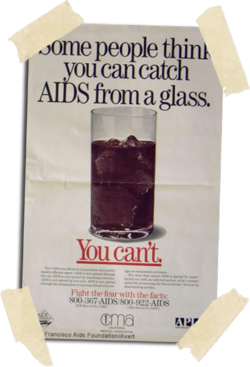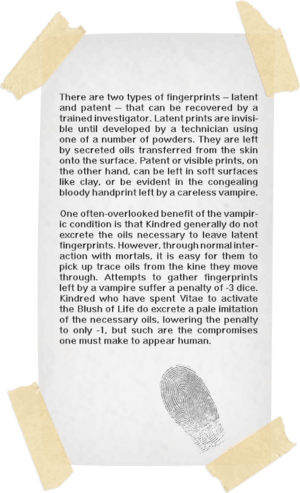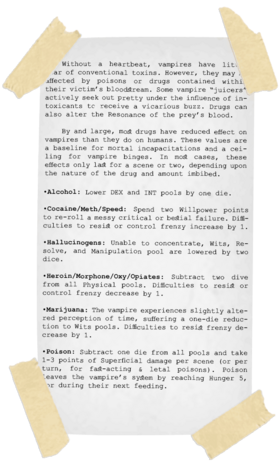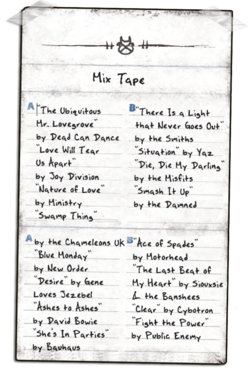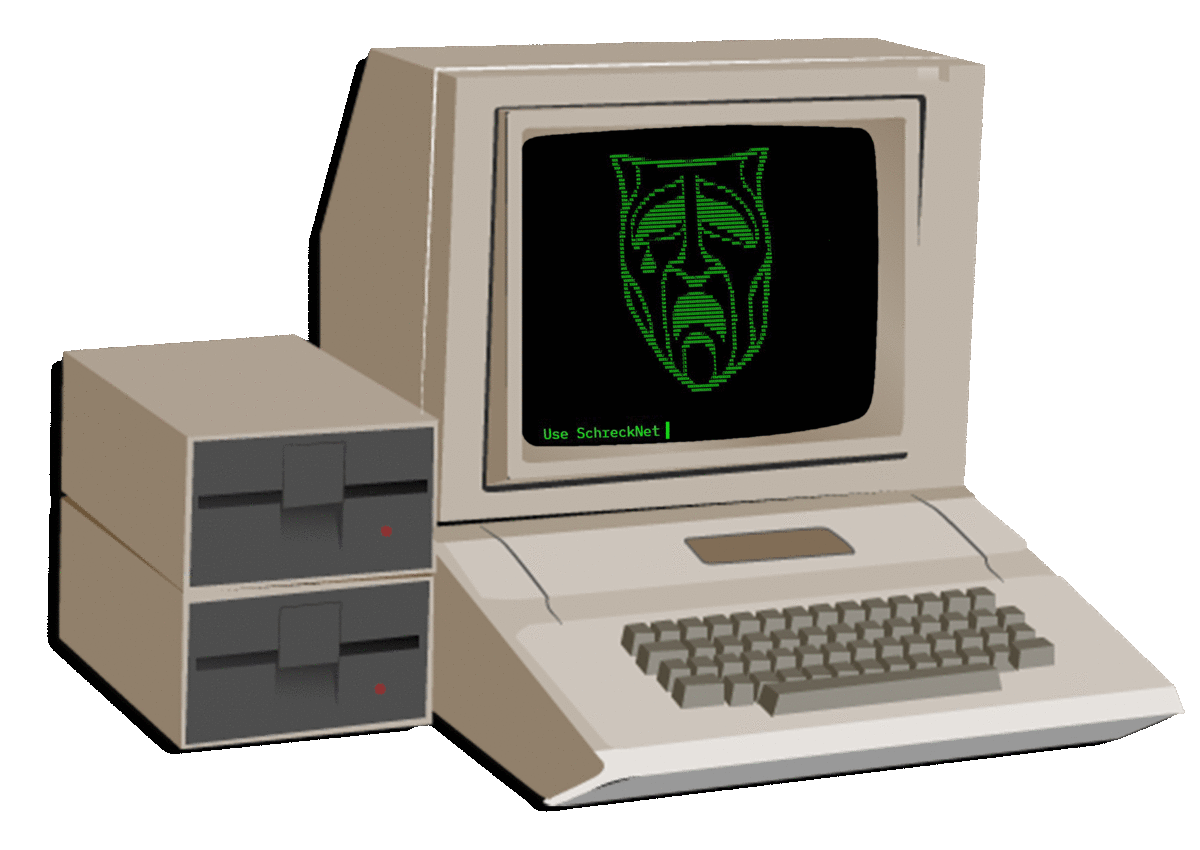The 80s: Difference between revisions
Jump to navigation Jump to searchm (Protected "The 80s" ([Edit=Allow only administrators] (indefinite) [Move=Allow only administrators] (indefinite))) |
mNo edit summary |
||
| Line 262: | Line 262: | ||
These bands and their followers amuse and offend the Kindred in equal measure. Their pale skin and androgynous styles make them seem like it would be perfect for real vampires to hide and hunt among them, but only the youngest of Kindred actually do so. The goth scene is full of people claiming to be vampires, and the word is thrown around with a bit too much freedom for most Kindred to ever feel truly comfortable. Couple that with the fact that goths tend to stand out, and it becomes clear why many Elders typically discourage fraternization. | These [[bands]] and their followers amuse and offend the Kindred in equal measure. Their pale skin and androgynous styles make them seem like it would be perfect for real vampires to hide and hunt among them, but only the youngest of Kindred actually do so. The goth scene is full of people claiming to be vampires, and the word is thrown around with a bit too much freedom for most Kindred to ever feel truly comfortable. Couple that with the fact that goths tend to stand out, and it becomes clear why many Elders typically discourage fraternization. | ||
Revision as of 14:10, 6 October 2021
THE AMERICAN LANDSCAPE
The Moral Majority
In 1978, the IRS seeks to revoke tax exemptions for schools formed as white-flight havens from desegregated public schools. The backlash is overwhelming, with Congressional hearings reframing the issue as an attack on religion. In the following year, Baptist minister Jerry Falwell — who ran and profited from a segregated academy — forms the Moral Majority. Galvanizing white evangelicals against what they perceive to be the moral decline of society, they seek to introduce a new social agenda into American politics.
Falwell plays a significant role in the election of Ronald Reagan to the presidency in 1980, and in following years seeks to turn national opinion against topics of abortion, pornography, the exclusion of prayer in public schools, and the Equal Rights Amendment. In particular, the anti-gay rights rhetoric publicized through Christian broadcasting explicitly characterizes the movement as an attack on the American family, with Falwell expressing that homosexuals are castoffs from society with no choice but to sexually prey on children.
The decade closes with conservative Christian organizations in decline. Reagan's two terms in office provide eight years of Christian Right-supported leadership, but also sees a decrease in donations as the state of moral peril no longer exists. Falwell eventually dissolves the Moral Majority in 1989, just one year after televangelist Pat Robertson's failed presidential bid.
The Blood Scare
For the first time in all but the oldest of active Kindred’s memories, vampires have been confronted by a worldwide plague that is borne in the central facet of their existence. HIV, AIDS, or GRID – depending on who you speak to – has the potential to change everything for vampire society, and is a hot-button topic in Elysiums all over the world. What does a blood-drinker do when blood suddenly becomes a toxic substance?
AIDS is largely ignored by the Reagan administration for the first half of the decade, and is viewed as a problem of homosexual society. Research is stifled by lack of funding, and little is understood about this virulent new disease. Rumors spread like wildfire through the Kindred community. Some glory in this new plague and use it to proselytize. A sure sign, they say, of God’s wrath, a plague directly out of Revelations, sent to destroy humanity for their sins. Others whisper about the Lamia bloodline, and particularly paranoid Kindred wonder if they might indeed be responsible.
AIDS changes the game. Where feeding was once fairly straightforward as long as the Kindred remained discreet, there is a new uncertainty. Is the well tainted? To some, every mortal’s face now looks gaunt and flush with fever. While vampires are personally unaffected by AIDS, their kiss could lead to infection within mortal herds. Unsurprisingly then, some Kindred anonymously fund research centers looking into the AIDS epidemic, including Pentex subsidiaries such as Magadon, Inc.
The Satanic Panic
Thanks partly to the rise of conservative Christianity, and partly because of the lurid nature of the subject, Satanism is a hot topic. In 1980, the book "Michelle Remembers", by a psychiatrist named Lawrence Pazder, details a series of hypnotherapy sessions with his wife. Over the course of those sessions, she reveals suppressed memories of being molested and abused by a satanic cult as a child. The book spawns a decade of similar “confessions” from adult survivors of ritual abuse before being debunked in the 90s.
Musicians are accused of hiding infernal messages in their records to train sleeper agents via subliminal conditioning. These instructions are only decipherable by playing the LP backwards. Role-playing games and fantasy fiction are likewise targeted as a recruiting ground for cultists. These theories are all propagated by occult experts who make their livings as witnesses in trials across the country, blaming everything from vandalism to murder on an apparently vast conspiracy of cultists worshiping Satan. Though the evidence is more closely compared to the blood libel and witch-hunts of historical Europe, and McCarthyism of the 20th century, especially as ritual abuse allegations often target out-groups such as radical feminists, atheists, and homosexuals.
The moral panic surrounding Satanic ritual abuse brings together several groups normally unlikely to associate, including psychotherapists, self-help groups, religious fundamentalists, and law enforcement. The FBI creates an Occult Crimes division to investigate incidents of cult activity, and many vampires find themselves under suspicion thanks to their necessarily strange and unusual habits.
Law Enforcement
Police investigative techniques are in the realm of footwork
and contacts. Forensics is still a relatively new field, and
fingerprints are state-of-the-art. DNA evidence, computer-aided
ballistics modeling and other tricks are still a dream of
the far-flung future. Even AFIS, the Automated Fingerprint
Identification System, takes an inordinate amount of time
and requires resources out of the reach of many smaller
police departments.
The biggest threat to any Kindred, from a legal standpoint,
is the well-connected and tenacious detective willing to do
the footwork. Unwilling or unable to let an investigation drop,
and positioned so that he can’t just be eliminated, this sort
of cop requires finesse or brute force political clout. Luckily,
neither option is in short supply to 80s Kindred.
The Second Inquisition
Created in 1985 by the FBI, the Violent Criminal Apprehension Program (ViCAP) begins operating out of Quantico. The unit is responsible for the analysis of serial violent and sexual crimes by linking their signature aspects, including cases decades old or in widely separated states. Designed to track and correlate information on violent crime, this database becomes the cornerstone of the nascent PROJECT: FIRSTLIGHT, or as Kindred are apt to call it, the Second Inquisition.
Occult experts begin to proliferate law enforcement at all levels. Most are hacks chasing false allegations of ritual abuse, but some do — on occasion — stumble upon a careless vampire. Many of these so-called Inquisitors operate alone, fearful of being laughed out of the bureau. Still others have carved out small cells from within the ranks of larger organizations, sharing intel through inter-agency channels like ViCAP. Even the most informed of these hunters tend to be operating off of half truths when it comes to the Kindred, but they are no less dangerous for it. The most fearsome of which are those sponsored through the Catholic Church byway of the Society of Leopold, who have a tradition of monster slaying stretching back centuries.
THE INTERNATIONAL LANDSCAPE
The Cold War
In a perfect example of how Americans in the 80s deal with their problems, the president has built up satellite weapons to protect against the enemies of democracy. What was a slow-burning propaganda war is suddenly waiting for a flashpoint that could come at any time. An underlying current of paranoia and fear rests at the heart of the 80s. Even the Kindred exist in the tense shadow of nuclear threat. Theirs is no true immortality, and global thermonuclear war would almost certainly be the extinction of both Kindred and kine.
But the Kindred are nothing if not contentious, and they too take sides in the conflict between mortal ideologies. Even Anarchs betrayed by the long-term failures of the Russian Revolution find themselves facing off against champions of democracy in Elysium.
The Iran-Iraq War
The 1979 Islamic Revolution sees the overthrow of the last Shah of Iran, and the end of the 2,500 year old Persian monarchy. Following this, Ruhollah Khomeini is elevated to Grand Ayatollah. He immediately calls for the expansion of theocratic political rule by Islamic purists, calling democracy the equivalent of prostitution.
Following the outbreak of the Iran-Iraq War, oil production in Iran nearly stops, while Iraq's is sharply cut. Economic recessions are triggered in the United States, with oil prices not subsiding until the mid-1980s. This creates particular unease in New York, as the state institutes an odd-even gas rationing during the oil crisis. Due to this, smaller and more fuel-efficient Japanese automobiles surpass American production totals, becoming the first in the world. This forces Detroit's "Big Three" automakers to shift focus, releasing downsized compact cars in the mid 1980s, like the Chevrolet Cavalier and the Ford Tempo.
The Beckoning
The Sabbat all but desert their worldwide holdings en masse and travel to the Middle East, using the erupting war zones as cover to root out and kill Antediluvians. Conversely, the aligned Camarilla and Ashirra seek to contain the Sabbat, uphold the Masquerade, and protect the graves of slumbering Methuselah.
For reasons unclear, Elder Kindred around the world are randomly subject to a supernatural Beckoning, which compels them to travel to the general area of the Fertile Crescent, the Levant, the Maghreb, and even into Ukraine. Kindred of the Seventh Generation and lower have been shown to be susceptible. The power vacuum left in place of these departing elders threatens to destabilize entire domains. Still some attempt to avoid the Beckoning by holing themselves up in their havens, and engorging themselves on the blood of neonates.
The precise nature and origin of the Beckoning is unclear, though many fear that one or more Antediluvians have begun to awaken from torpor and are calling their childer to protect them — or to be devoured. It is however a little known fact that the Elders of the Hecata are not affected, perhaps already having built up a resistance after their progenitor "beckoned" the original Clan of Death to the Feast of Folly. Likewise, clan Ravnos seems unaffected, most likely due to the awakening and destruction of their Antediluvian during the Week of Nightmares.
The Iran-Contra Affair
In a effort to remove the Ayatollah Khomeini from power, members of the United States government circumnavigate embargo to make a deal wherein the Israelis will provide arms to moderate Iranian insurgents, and the United States would pay the Israelis for their purchases. In return, the insurgents would do everything in their power to free American hostages held by Iranian terrorists in Lebanon. But of the 30 million dollars that were earmarked for this purpose, only 12 million actually go into buying arms for the Iranians. Three hostages are released and three more are taken, turning the deal into a vicious cycle of, essentially, trading material that could be used to take more hostages.
In addition, the missing funds are diverted to help back Nicaraguan guerrilla contras against Cuban-backed Sandinistas. Multiple investigations find no evidence that Reagan himself is involved, but eleven high-ranking officials are convicted, though they are later pardoned by George H.W. Bush.
The Crack Epidemic
The influx of Nicaraguan cocaine starts and significantly fuels the 1980s crack epidemic, with profits allegedly being funneled to the CIA-supported Contras.
Crack cocaine is disproportionately taken up by poor neighborhoods, while the original powdered version remains popular in wealthier areas. It quickly becomes the center of illicit drug trade — contributing to thousands of overdose deaths as well as a spike in murders and violent crime throughout the 1980s. Crack addiction strangles black communities in particular, which are only further harmed by the resulting backlash in the form of "tough on crime" policies.
In 1986, Congress passes laws that create a 100:1 sentencing disparity for possession or trafficking of crack when compared to penalties for powder cocaine. This is widely criticized as discriminatory, as inner city minorities are more likely to use crack than powder cocaine. The media portrayals are exceedingly hostile, playing up stories of gang-related crime, so-called "crack babies", and warning of a new generation of addicted and violent youth dubbed "superpredators".
THE TECHNOLOGICAL REVOLUTION
Camcorders
Video cassette recorders and, more frightening from a Kindred perspective, cheap and easy home video cameras open the door to vast new horizons of blackmail material and Masquerade breaches. It isn’t simply the fear that some amateur might record a specific vampire in the midst of some horrific act. Any recording of a vampire, even a fuzzy video of one walking down the street, has the potential to pull back the curtain and shatter the Masquerade. It is a dangerous new angle that the Kindred must learn and quickly attempt to internalize to the point of instinct. Conversely, video cameras give the Kindred a new tool to use to exert their poisonous influence over mortals or even other vampires. Often, a video of an illicit liaison is just as effective as Dominate at getting a local politician to pledge his loyalty, and requires much less maintenance.
Members of clan Lasombra are rumored to have no reflection. As such, they do not show up in photographs or on video recordings. Conjecture varies, with some claiming that the Lasombra exist on a slightly different frequency than others, flickering in and out of light. Others still suppose the pure silver traditionally used in mirrors and film have some supernatural effect on them.
Cassette Culture
In 1980, Sony releases their portable cassette player — The Walkman — in the United States. Largely responsible for originating the proliferation of small, Japanese tech gadgets, the Walkman more immediately revolutionizes the way people listen to music. Its portable form factor, relatively tiny headphones, and surprisingly decent audio fidelity almost immediately supplant boomboxes the country over. As the first real device to allow personal recording of radio songs, the Walkman spawns the now ubiquitous "mix-tape". These mix-tapes become as personal as the individual listener, being crafted for everything from exercise soundtracks in the burgeoning aerobics craze, to a hot gift to exchange in romantic courtship.
Telephony
Telephones are a novelty for many Kindred. The preferred means of communication for most vampires in the 80s is still the letter. Of course, vampiric paranoia being what it is, many elders choose to send their messages from city to city via ghoul or vampiric courier. It is not uncommon for messages to disappear in transit, with no sign of the foolhardy vampires who thought they were cunning or tough enough to survive the nomadic trek.
Telephones are still mostly tethered by cords. Cordless phones are expensive and poorly made. Mobile phones exist barely, and only in bulky car phone models. Pagers are a brand new technology, and, along with mobile phones, are only found among the richest of the rich. Doctors, executives, and drug dealers are the primary consumers of mobile communications. Payphones are still the most ubiquitous way of communicating quickly, no matter where you are.
Some enterprising souls, called “phone phreaks,” have turned to methods ranging from laughably simple (Captain Crunch whistles) to highly sophisticated (devices that piggyback on service that belongs to other people) in order to steal phone service.
The Personal Computer
Personal computers are barely out of diapers; Apple is still the dominant platform, and the groundbreaking “1984” commercial doesn’t air until nearly halfway through the decade. Computers exist, in many ways, merely as potential in the 80s. The Internet is still mostly in academic use at this point, and the World Wide Web is a decade away. Despite that, many people (and many newly-embraced Kindred) are obsessed with the digital frontier.
This is not to say that computers aren’t in wide use. They are, but most take up huge rooms filled with reel-to-reel tape systems and punch cards. Still, the 80s are the first time that computers have left the office and come home.
Bulletin Board Systems
Computerized bulletin board systems and networks are tiny, loosely affiliated enclaves of computer users dialing into a central computer via modems or even acoustic couplers. On a BBS, users can chat, exchange messages, download and upload files, and even play rudimentary games. Bulletin board systems tend to have a very local appeal, since one must pay long-distance charges to call a BBS in another area code. Among the Kindred, as among mortals, bulletin boards are almost universally unknown.
There is an underground vampire-only BBS in New York called SchreckNet that is used as an informal digital Elysium. Used exclusively for communication among the Nosferatu, primarily as a means to keep their intelligence gathering operations up-to-date. Membership is not limited to Camarilla-aligned Nosferatu, and instead is open to all those in clan. But if the Prince ever discovers (and more importantly, grasps) the implications of the BBS, the Nosferatu will have much to answer for.
THE CULTURAL LANDSCAPE
New York Nightlife
Many of the city's nightspots are subject to so-called "cabaret laws" which prohibit live bands, singing, and dancing without the proper license. Most balk at the intentionally expensive and difficult to obtain license, especially given its arbitrary enforcement by New York police. Predominately white establishments — like those frequented by yuppies working in the newly constructed Trump Tower — are rarely, if ever, cited. Instead the law is weaponized against marginalized groups, targeting establishments that cater to black or gay patrons.
Founded in 1973, the music venue CBGB becomes more closely associated with hardcore punk acts throughout the 80s. It stands as one of the city's well established, yet still relevant scenes. Likewise, Andy Warhol's studio — The Factory — continues to be the hip hangout for experimental artists and musicians. It also serves as a cultural incubator, with Warhol showing particular disregard for conservative values through his films, which often feature same-sex relationships and a rotating cast of transgender actresses. Warhol's "superstars" find their fifteen minutes of fame are up when The Factory is closed in 1984.
Though rooted in the Harlem Renaissance of the 1920s, New York's ball culture comes into a golden age during the 1980s. Largely the purvey of uptown, these events mix dance, lip-sync, and modeling as "Houses" compete against one another. The extravagant performances simultaneously epitomize and satirize gender roles and social classes, while offering a sense of escapism for participants. The mainstream impact of New York's ballroom culture doesn't become apparent until the end of the decade, when Madonna popularizes voguing.
Music in the 80s
Disco takes its last breath in 1980, signaled largely by the closure of the Studio 54 nightclub. Motown and glam rock give way to heavy metal, as much of the scene turns hard and angry, exploding into punk. The punk mentality attracts many idealistic Anarchs, but anything that burns with the intensity of the original punk movement is doomed to fade, and by the mid-80s mohawks and safety pins are already relegated to the realm of irony. However, punk itself doesn't die. Instead, it sheds the skin of the Sex Pistols and is reborn in California, in the East Bay Hardcore scene.
In the urban centers, teens find an alternative to the violence of gang and drug culture. Artists like Jean-Michel Basquiat turn tagging and graffiti into an art form, while musicians explore the growing range of the nascent hip-hop movement. Originally built out of an accretion of break beats and music loops, turntable jockeys take pre-existing music and create new songs that speak to a new generation. Rhythmic chanting that echoes beat poetry, laid over the tracks creates the new and potent style of music known as rap. Run-DMC, LL Cool J, the Fat Boys and Public Enemy promote messages ranging from light-hearted fun to political diatribes in the burgeoning form.
Mainstream music is full of superstars, from Michael Jackson and Madonna, to “hair” rockers like Van Halen, Bon Jovi and Def Leppard. New Wave acts like Depeche Mode, A Flock of Seagulls, Eurythmics and Culture Club defy the prevailing machismo of the decade and lend an air of androgyny to the proceedings as spiritual descendants of David Bowie — who is still making music... and children’s films.
The end of the 70s also sees the birth of a new group of bands such as Joy Division, Siouxsie and the Banshees, The Cure, and Bauhaus. Groups that take the frenetic energy of punk, but turn it morose and moody. The subculture that grows up around these bands is called “goth.” Velvet, lace, and kohl eyeliner are de rigueur for both genders. Hair is, of course, huge. In the United States, the goth scene tends more toward a darker version of the punk do-it-yourself aesthetic, with fishnets on their arms, teased mohawks, and elaborate makeup on ghostly faces.
These bands and their followers amuse and offend the Kindred in equal measure. Their pale skin and androgynous styles make them seem like it would be perfect for real vampires to hide and hunt among them, but only the youngest of Kindred actually do so. The goth scene is full of people claiming to be vampires, and the word is thrown around with a bit too much freedom for most Kindred to ever feel truly comfortable. Couple that with the fact that goths tend to stand out, and it becomes clear why many Elders typically discourage fraternization.
